The Pavilion of Mexico
 The Mexican pavilion at Expo 67 was a striking white structure located at water's edge on Île Notre Dame.
The Mexican pavilion at Expo 67 was a striking white structure located at water's edge on Île Notre Dame.The pavilion's exterior was based on traditional architectural forms and reflected 2 aspects of Mexico. One part resembled an enormous seashell, recalling the country's coastline, while the remainder (where the pavilion's entrance was found) was designed as a barren hill, complete with Mayan temple made of ancient stones, representing the arid Yucatan climate.
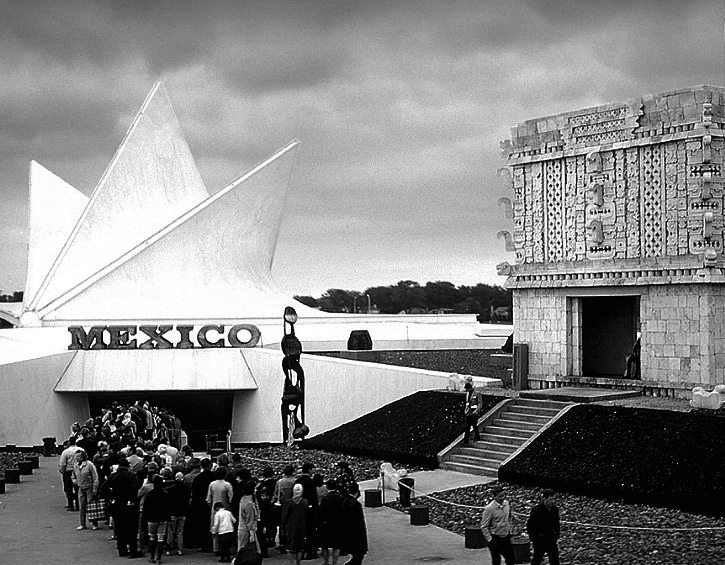 The theme chosen for the pavilion was "The Mexican and His World".
The theme chosen for the pavilion was "The Mexican and His World".A large mural by Mexican artist Rufino Tamayo immediately greeted the visitor entering the pavilion. Measuring an imposing 42 feet high by 15 feet long, the work symbolized the Mexican people freeing themselves from myths and constrictive nationalism, reaching out into universality.
A collection of photographs of Mexico's natural beauty, history, traditions, social progress and industrialization was presented in the pavilion's first hall. Large images of mines, farms, and beaches showed Mexico's resources, rich in number and variety. A display of vegetable exhibits reminded the visitor that it was Mexico that introduced corn, chocolate, the tomato and the pimento to the world. Also in this hall, a model of the Piramide de Los Nichos, with its 365 alcoves studding its 4 sides, was surrounded by statues of gods of pre-Columbian mythology.
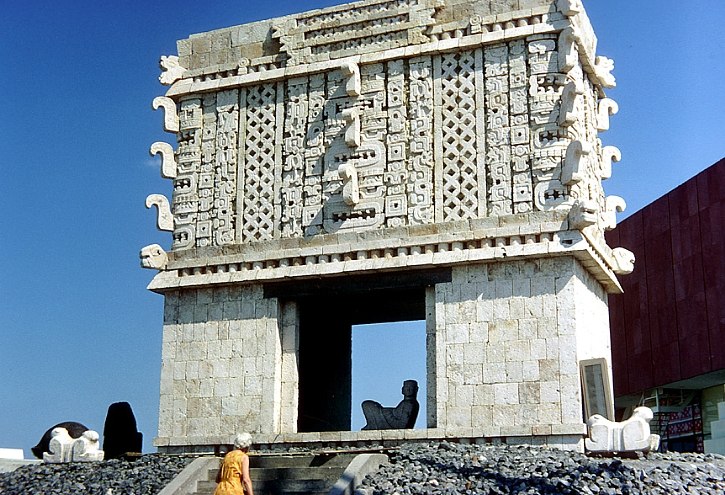 At the threshold of the pavilion's largest hall, a statue of an Olmec prince greeted the visitor with an invitation to explore the worlds of the Mayas, Toltecs and Aztecs. Stone figures embodied fascinating yet disturbing memories of dead civilisations. Also on display in this hall, a rich collection of pre-Columbian art, as well as religious and secular art objects of New Spain, dating back to the 16th century.
At the threshold of the pavilion's largest hall, a statue of an Olmec prince greeted the visitor with an invitation to explore the worlds of the Mayas, Toltecs and Aztecs. Stone figures embodied fascinating yet disturbing memories of dead civilisations. Also on display in this hall, a rich collection of pre-Columbian art, as well as religious and secular art objects of New Spain, dating back to the 16th century. A painted wooden sculpture of Christ, typical of the Mexican baroque period.
A painted wooden sculpture of Christ, typical of the Mexican baroque period.Full sized replicas of the 3 Bonampak chambers, featuring the most ancient frescos in the Americas, evoked the grandeur of the Mayan civilization. These vast works in tones of red, yellow, ochre and green covered the inside and outside walls; a reliable portrayal of the period's customs, clothes and events, and the finest examples of classic Mayan painting.
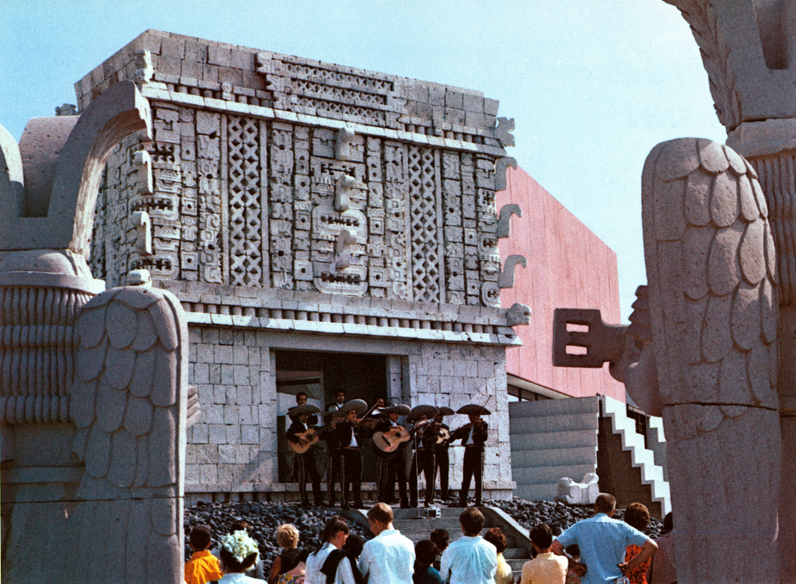 Nearby, the serene beauty of basalt masks inlaid with mosaics and terra cotta funerary statuettes sharply contrasted the rich Bonampak murals. Also on display was a colossal caryatid, one of eight that once supported a temple roof dedicated to the planet Venus, in the sacred city of Tula. An 18th century baroque altar of gold and silver was brought in from Tepotzotlan.
Nearby, the serene beauty of basalt masks inlaid with mosaics and terra cotta funerary statuettes sharply contrasted the rich Bonampak murals. Also on display was a colossal caryatid, one of eight that once supported a temple roof dedicated to the planet Venus, in the sacred city of Tula. An 18th century baroque altar of gold and silver was brought in from Tepotzotlan.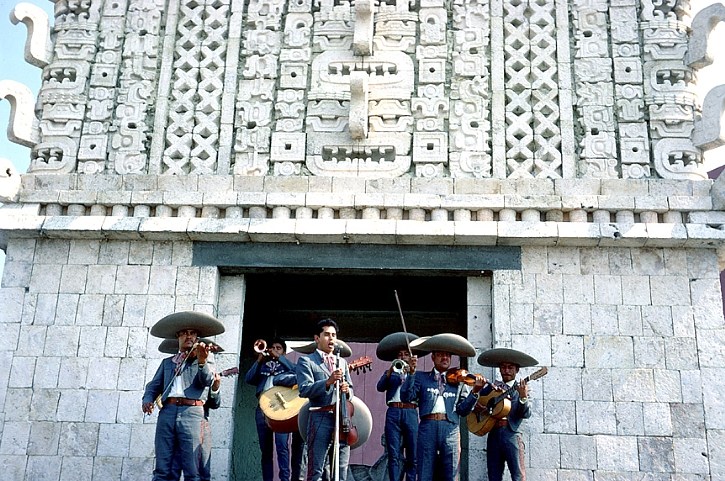 In yet another hall, an important collection of paintings done in 1966 by young Mexican artists illustrated the theme of "The Mexican Facing the World". The works portrayed mankind's relation with Nature, Love, the Community, the Universe and Infinity. A kinetic sculpture came to life at the slightest breath of air, while a composition of metal shapes was set in motion magnetically over a black marble base.
In yet another hall, an important collection of paintings done in 1966 by young Mexican artists illustrated the theme of "The Mexican Facing the World". The works portrayed mankind's relation with Nature, Love, the Community, the Universe and Infinity. A kinetic sculpture came to life at the slightest breath of air, while a composition of metal shapes was set in motion magnetically over a black marble base. The folk art decor of the Mexican pavilion restaurant.
The folk art decor of the Mexican pavilion restaurant.The pavilion's Acapulco bar and adjoining Santa Anita restaurant served typical Mexican fare. Here visitors could admire folk art decor while sipping tequila and sampling dishes such as giant shrimps in pepper sauce, or fish stuffed with almonds... all to the nostalgic guitars and trumpets of the popular mariachi band.
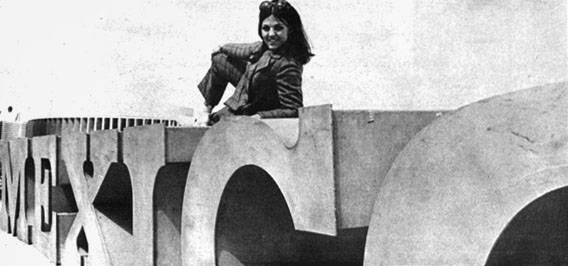 Michele Richard, posing coquettishly at the Mexican pavilion.
Michele Richard, posing coquettishly at the Mexican pavilion.images: (1-4-5-8) personal collection
(2-3-6) expo67.ncf.ca
(7) digital.library.mcgill.ca/expo-67
Labels: pavilions-a-gogo

4 Comments:
I like the way you sneaked in the photo of Michèle Richard!!
...whenever and wherever I can! ;-)
Your website is infinitely fascinating!
I love it!
thank you,
John
Thank you, John!
Post a Comment